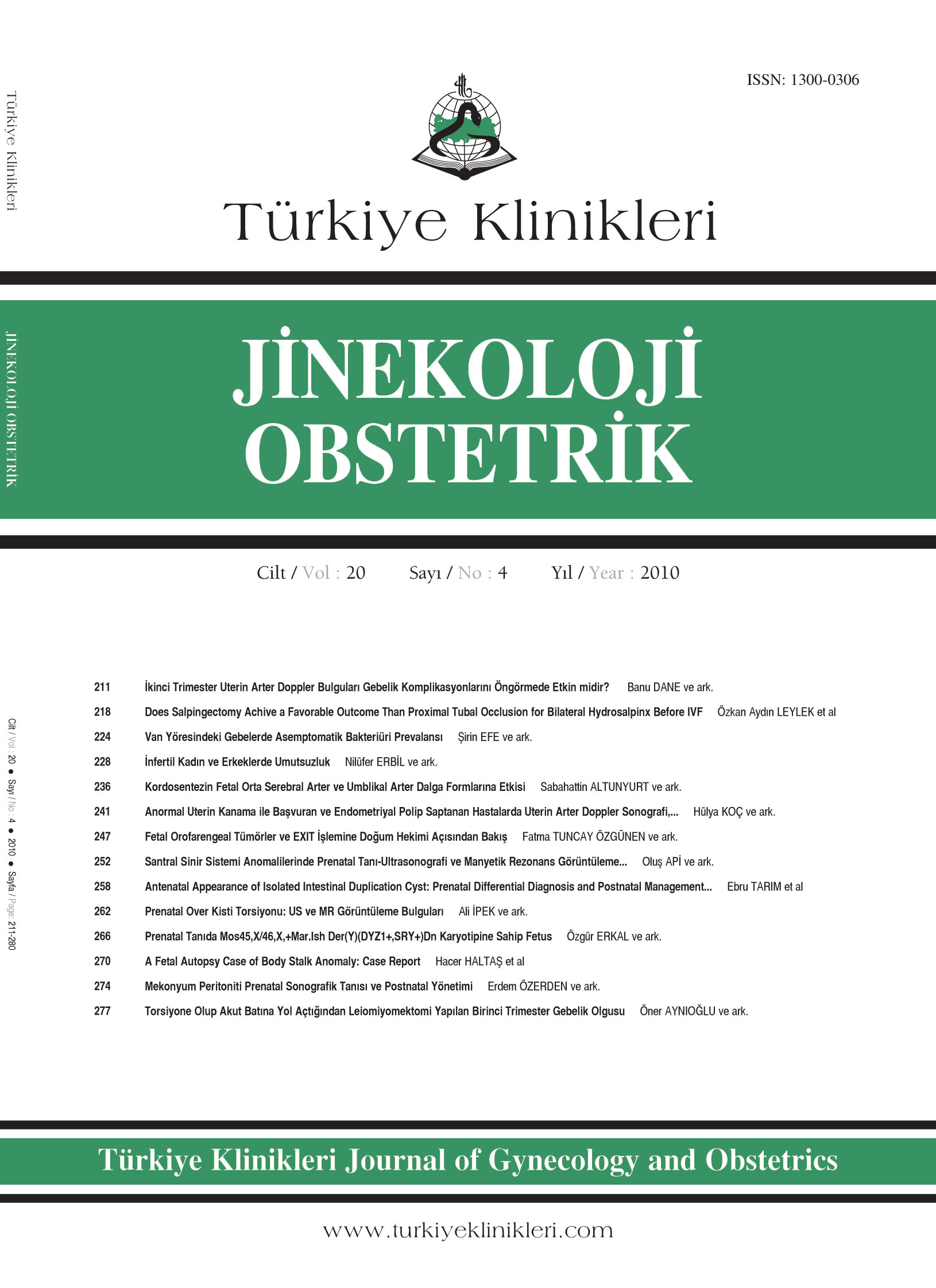Open Access
Peer Reviewed
CASE REPORTS
3123 Viewed1211 Downloaded
Prenatal Diagnosis in Central Nervous System Anomalies-Concomitant Use of Ultrasonography and Magnetic Resonance Imaging Findings: Case Report
Santral Sinir Sistemi Anomalilerinde Prenatal Tanı-Ultrasonografi ve Manyetik Rezonans Görüntüleme Bulgularının Eş Zamanlı Kullanımı
Turkiye Klinikleri J Gynecol Obst. 2010;20(4):252-7
Article Language: TR
Copyright Ⓒ 2025 by Türkiye Klinikleri. This is an open access article under the CC BY-NC-ND license (http://creativecommons.org/licenses/by-nc-nd/4.0/)
ÖZET
Santral sinir sistemi (SSS) anomalileri, en sık görülen konjenital malformasyonlar arasında bulunmaktadır. Ultrasonografi, SSS anomalilerinin tanısında başlıca tarama yöntemidir. Ancak, özellikle nöral tüp kapanma defekti olmayan SSS malformasyonlarının spesifik tanısında ultrasonografi yeterli olmayabilmektedir. Son yıllarda fetal serebral manyetik rezonans görüntüleme (MRG), özellikle seçilmiş olgularda ve 20-22. gebelik haftaları sonrasında tanıda oldukça yardımcı olan bir teknik olarak kullanılır hale gelmiştir. Burada sunulan ilk olguda, SSS incelemesinde ventrikülomegali ve kolposefali tespit edilip, ayrıca kavum septum pellusidum gözlenmemiştir. Fetal MRG'de, korpus kallozum agenezisi tanısı doğrulanmıştır. İkinci olguda, detaylı obstetrik incelemede, vertebral kolonda angulasyon, spinal kanalda daralma ve kemik çıkıntı saptanmıştır. Kifoskolyoz ve diastematomiyeli tanısı fetal MRG ile doğrulanmıştır. Son olgunun fetal SSS incelemesinde falks serebri anterior kısımda gözlenmezken, talamik çekirdekler ve kavum septum pellusidum hiç izlenmemiştir. Öntanı lobar veya semilobar holoprozensefali olarak konmuştur. Yapılan fetal MRG'de, semilobar holoprozensefali tanısı doğrulanmıştır.
Santral sinir sistemi (SSS) anomalileri, en sık görülen konjenital malformasyonlar arasında bulunmaktadır. Ultrasonografi, SSS anomalilerinin tanısında başlıca tarama yöntemidir. Ancak, özellikle nöral tüp kapanma defekti olmayan SSS malformasyonlarının spesifik tanısında ultrasonografi yeterli olmayabilmektedir. Son yıllarda fetal serebral manyetik rezonans görüntüleme (MRG), özellikle seçilmiş olgularda ve 20-22. gebelik haftaları sonrasında tanıda oldukça yardımcı olan bir teknik olarak kullanılır hale gelmiştir. Burada sunulan ilk olguda, SSS incelemesinde ventrikülomegali ve kolposefali tespit edilip, ayrıca kavum septum pellusidum gözlenmemiştir. Fetal MRG'de, korpus kallozum agenezisi tanısı doğrulanmıştır. İkinci olguda, detaylı obstetrik incelemede, vertebral kolonda angulasyon, spinal kanalda daralma ve kemik çıkıntı saptanmıştır. Kifoskolyoz ve diastematomiyeli tanısı fetal MRG ile doğrulanmıştır. Son olgunun fetal SSS incelemesinde falks serebri anterior kısımda gözlenmezken, talamik çekirdekler ve kavum septum pellusidum hiç izlenmemiştir. Öntanı lobar veya semilobar holoprozensefali olarak konmuştur. Yapılan fetal MRG'de, semilobar holoprozensefali tanısı doğrulanmıştır.
ANAHTAR KELİMELER: Ultrasonografi; manyetik rezonans görüntüleme; prenatal tanı; santral sinir sistemi hastalıkları
ABSTRACT
Central nervous system (CNS) anomalies are among the most common congenital malformations. Ultrasonography is the leading screening method for the diagnosis of CNS anomalies. However, ultrasonography may not diagnose CNS malformations especially those without neural tube closure defects. In the recent years, fetal cerebral magnetic resonance imaging (MRI) has been used as a useful diagnostic tool in detecting selected cases between 20-22 weeks of gestation. In the first case presented here, upon CNS ultrasonographic evaluation, ventriculomegaly and colpocephaly were detected and cavum septum pellucidum was not visualised. Agenesis of the corpus callosum was confirmed by fetal MRI. In the detailed ultrasonographic evaluation of the second case, angulation in the vertebral colon and narrowing of the spinal canal and bony spur traversing the spinal canal were detected. The diagnosis of kyphoscoliosis and diastematomyelia was confirmed by fetal MRI. In the fetal CNS examination of the third case, falx cerebri was not visualised in the anterior segment, the thalamic nuclei and cavum septum pellucidum were not visualised at all. The prediagnosis was semilobar holoprosencephaly. In the fetal MRI, the diagnosis of semilobar holoprosencephaly was confirmed.
Central nervous system (CNS) anomalies are among the most common congenital malformations. Ultrasonography is the leading screening method for the diagnosis of CNS anomalies. However, ultrasonography may not diagnose CNS malformations especially those without neural tube closure defects. In the recent years, fetal cerebral magnetic resonance imaging (MRI) has been used as a useful diagnostic tool in detecting selected cases between 20-22 weeks of gestation. In the first case presented here, upon CNS ultrasonographic evaluation, ventriculomegaly and colpocephaly were detected and cavum septum pellucidum was not visualised. Agenesis of the corpus callosum was confirmed by fetal MRI. In the detailed ultrasonographic evaluation of the second case, angulation in the vertebral colon and narrowing of the spinal canal and bony spur traversing the spinal canal were detected. The diagnosis of kyphoscoliosis and diastematomyelia was confirmed by fetal MRI. In the fetal CNS examination of the third case, falx cerebri was not visualised in the anterior segment, the thalamic nuclei and cavum septum pellucidum were not visualised at all. The prediagnosis was semilobar holoprosencephaly. In the fetal MRI, the diagnosis of semilobar holoprosencephaly was confirmed.
MENU
POPULAR ARTICLES
MOST DOWNLOADED ARTICLES





This journal is licensed under a Creative Commons Attribution-NonCommercial-NoDerivatives 4.0 International License.










